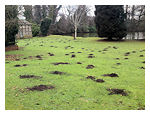General Information
Size: Up to 7 inches long
Weight: 3 to 4 ounces

Moles can sometimes be confused with shrews or pocket gophers. They have a hairless, pointed snout that can extend close to a ½ inch in front of their mouth opening. They have small eyes and the openings of the ear canal are covered in the fur; there are no external ears. Their forefeet are very large and wide, while their hind feet are small and narrow, with slender, sharp claws. They have one liter each year. It is said a 5oz mole can consume 45-50 pounds of worms and insects in a year. It is also reported that mole’s surface tunnels can be dug at a rate of about 18ft per hour and that a mole can race through an existing tunnel at about 80ft per minute.
Habitat
The mole lives in the isolation of underground burrows, and they rarely come up to the surface. Moles reside in high burrows with dry spots, but they prefer to track in soil that is shaded, cool, moist, and populated by worms and grubs. This is why moles prefer parks and lawns. The largest portion of a mole’s diet is the earthworm. The most important thing to know about moles is that they will move into the vacant dens and tunnel systems of other moles. This means that even though one mole is removed, others may find and re-establish the same area.
Damage

Moles burrowing habits can cause damage to lawns and parks, destroy flowerbeds, tear up the roots of grasses, and damage small garden plots. Moles also damage landscape edging. Moles leave volcano-shaped hills that are often made up of clods of soil. The molehills are raised up from the deep tunnels and may be 2 to 24 inches (5 to 60cm) tall. Most of the time mole mounds can be confused with gopher mounds, but the difference is that mole mounds are spaced out, while gopher mounds run in a line with a deeper tunnel system. Mole activity in your lawn, golf course or fields can tear through water lines, which can lead to costly flood damage. Moles can also break through cables, which can affect phones or any other utility you receive through underground lines. They are also known to destroy sprinkler systems by uprooting sprinkler heads and warping underground water lines.
[restab title=”Disease”]Moles rarely but sometimes can be carriers of rabies. Rabies, a virus, gradually paralyzes and can kill any mammal, including humans. Rabies can only be contracted through biting. Though humans should avoid contact with any mole.
Control
Since there are no repellents proven effective, and toxicants are not readily accepted due to the mole’s diet, trapping is really the only option. Because of the time and man hours involved in trapping moles, the service can be expensive. Companies that trap moles correctly must constantly check and relocate traps. Beware of companies offering a fast solution to mole problems. Metro Guard does not currently offer mole trapping services. We do sell mole traps and offer advice to anyone interested in a “do it yourself” approach.


Follow Us